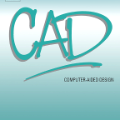We present a novel AI-assisted method for decomposing (segmenting) planar CAD (computer-aided design) models into well shaped rectangular blocks as a proof-of-principle of a general decomposition method applicable to complex 2D and 3D CAD models. The decomposed blocks are required for generating good quality meshes (tilings of quadrilaterals or hexahedra) suitable for numerical simulations of physical systems governed by conservation laws. The problem of hexahedral mesh generation of general CAD models has vexed researchers for over 3 decades and analysts often spend more than 50% of the design-analysis cycle time decomposing complex models into simpler parts meshable by existing techniques. Our method uses reinforcement learning to train an agent to perform a series of optimal cuts on the CAD model that result in a good quality block decomposition. We show that the agent quickly learns an effective strategy for picking the location and direction of the cuts and maximizing its rewards as opposed to making random cuts. This paper is the first successful demonstration of an agent autonomously learning how to perform this block decomposition task effectively thereby holding the promise of a viable method to automate this challenging process.
翻译:作为适用于复杂 2D 和 3D CAD 模型的一般分解方法的一项原则证明,我们提出了一种新型的AI 辅助方法,用于将(分解) 平面 CAD (计算机辅助设计) 模型分解成形状精密的矩形区块,作为适用于复杂 2D 和 3D CAD 模型的一般分解方法的证明原则。分解区块对于产生优质的中间件(四边形或六面形)是需要的,适合根据保护法对物理系统进行数字模拟的。六面网状生成一般 CAD 模型的问题已经困扰了30多年,而分析员往往花费50%以上的设计-分析周期时间将复杂的模型分解成现有技术可以覆盖的更简单的部分。我们的方法是用强化学习来训练一个代理商对 CAD 模型进行一系列最佳的削减,从而导致质量良好的分解。我们表明,代理商很快学会了一种有效的战略来选择削减的地点和方向,并尽量增加其报酬,而不是随机削减。 这份文件是一名代理商首次成功地学习如何以有效的方式执行这一块分解任务的方法。



